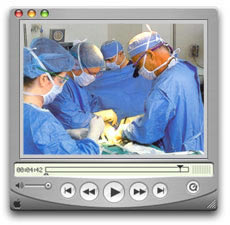How to Get Tubes Untied: Reverse Tubal Ligation
.
What is Reverse Tubal Ligation? Reverse tubal ligation - or more properly, tubal ligation reversal - is a procedure to get tubes untied for women who desire a pregnancy after tubal ligation. There are actually several procedures that can be used to untie tubes after the tubes have been tied.
Techniques of Reverse Tubal Ligation
- Tubal anastomosis
- Tubal implantation
- Salpingostomy (Fimbriectomy Reversal)
 Tubal Anastomosis
Tubal Anastomosis
The most common method for untying tubes is the reverse tubal ligation procedure of tubal anastomosis. Anastomosis refers to joining two body parts, and tubotubal anastomosis is joining two tubal segments together. Most techniques that tie tubes result in two separate tubal segments, so the simplest way to get tubes untied in these cases is with the anastomosis procedure.For more details about untying tubes via tubal anastomosis, see the topic on Tubal Reversal by Tubal Anastomosis on the Tubal Reversal Blog and the description of Microsurgical Tubal Anastomosis on the Chapel Hill Tubal Reversal Center website.
What is the Cost of Untying Tubes?
Reverse tubal ligation is usually described as extremely expensive, ranging from $10,000 to $30,000. The tubal anastomosis procedure to untie tubes costs $5900 at Chapel Hill Tubal Reversal Center. Because it is done as outpatient surgery and performed four times a day, the cost savings is passed on to the women who want kids after tubal ligation.Watch Dr. Berger Untie Tubes
The tubal reversal operation by Dr. Berger has been featured on television - this video clip on YouTube is 3 minutes long. To watch the entire operation, you can order a free video or DVD of tubes untied.Other Methods to Untie Tubes
Tubal implantation and salpingostomy are less frequent techniques to untie the tubes after a tubal ligation. For descriptions of these techniques, see the topic on Tubal Reversal by Tubal Implantation and Tubal Reversal by Salpingostomy on the Tubal Reversal Blog or Read the section on Reversal Illustrations on the Chapel Hill Tubal Reversal Center website.7 Responses to “How to Get Tubes Untied: Reverse Tubal Ligation”
- Tubal Reversal » What to Know if You Want Tubes Untied Says:
April 26th, 2008 at 6:55 pm [...] This summary is to help women who want to get their tubes untied. The first thing to know is what tying tubes actually means. It is not as simple as placing a string around the tube that can later be untied. Contrary to what some people think, tubes don’t become untied by themselves after a certain length of time. With this basic information about the fallopian tube and tubal ligation methods in mind, I will explain how reversal of tubal ligation is done in the next topic Tubal Reversal Blog - How to Get Tubes Untied: Reverse Tubal Ligation. [...] - Julia Smith RN Says:
April 26th, 2008 at 7:03 pm I know that our patients and potential patients wil find this information interesting, especially the video clip showing Dr. Berger performing a reversal. Many of the women I talk to feel confused about the type of sterilization they have had - or the difference between the techniques - and this blog will make that clearer. - Rhonda Brown RN Says:
April 27th, 2008 at 5:48 pm Information is the best gift that you can give anyone. Dr. Berger’s dedication to patient care begins even before they walk through the doors of his facility. Detailed information allows women to make the best choice for themselves and their families. - Charles Monteith MD Says:
April 27th, 2008 at 8:24 pm A clear concise introduction to untying tubes. It does not get any more straight forward or simpler than this. - Brandon Martin-Williams ST Says:
April 28th, 2008 at 12:12 pm This is a great way to familiarize yourself with the techniques used here at Chapel Hill Tubal Reversal Center. There are many ways to tie tubes. These are the ways, based on our statistics, that have proven to work best at untying tubes. - Pamela Mills CRNA Says:
April 28th, 2008 at 1:42 pm Very nice, I just can’t say enough about Dr Berger’s commitment to patient education in the field of tubal untying. - Stephanie Duncan RN Says:
April 28th, 2008 at 2:16 pm The illustrations on our website really do help give patients a better understanding of the process tying and untying tubes.



No comments:
Post a Comment